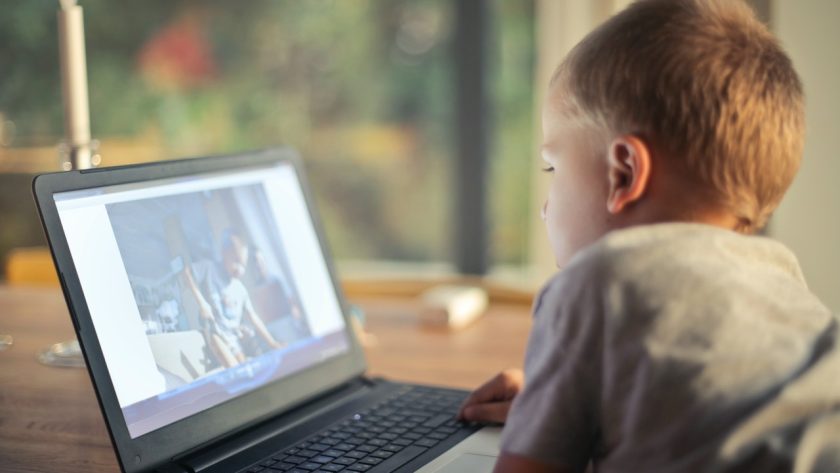The importance of monitoring children’s online activities during e-learning
With the increasing prevalence of e-learning platforms, it is crucial for parents to actively monitor their children’s online activities. While these platforms offer numerous educational opportunities, they also come with potential risks and dangers that need to be addressed. By monitoring their children’s online activities, parents can ensure a safe and secure learning environment.
One of the main reasons why monitoring is important during e-learning is to protect children from inappropriate content. The internet provides access to a vast amount of information, some of which may not be suitable for young learners. By actively supervising their online activities, parents can prevent them from stumbling upon explicit or harmful content that could negatively impact their development.
Additionally, monitoring allows parents to identify any potential cyberbullying incidents or instances where their child may be engaging in risky behaviors online. Cyberbullying has become increasingly prevalent in recent years and can have severe emotional consequences for victims. By staying vigilant and regularly checking on their child’s interactions on e-learning platforms, parents can intervene early and address any issues before they escalate.
In conclusion,
monitoring children’s online activities during e-learning plays a vital role in ensuring their safety and well-being. It allows parents to protect them from inappropriate content while also addressing concerns such as cyberbullying or risky behavior. By actively participating in their child’s digital education journey, parents can create a secure environment that promotes positive learning experiences.
Understanding the risks and dangers of unrestricted access to e-learning platforms
Unrestricted access to e-learning platforms can expose children to various risks and dangers. One of the main concerns is the potential for encountering inappropriate content. Without proper monitoring or filtering measures in place, children may stumble upon explicit material, violence, or other harmful content that could negatively impact their emotional well-being and development.
In addition to inappropriate content, unrestricted access also increases the risk of cyberbullying and online harassment. E-learning platforms provide avenues for interaction among students, but without parental control measures in place, children may be subjected to hurtful comments or targeted attacks from their peers. This can lead to significant psychological distress and affect their overall engagement with online learning.
Another danger of unrestricted access is the possibility of falling victim to online predators. These individuals often exploit vulnerable children by pretending to be someone else and establishing trust before engaging in harmful activities such as grooming or solicitation. By implementing parental control tools that monitor communication channels on e-learning platforms, parents can help protect their children from these potential threats.
It is crucial for parents and educational institutions alike to recognize these risks associated with unrestricted access to e-learning platforms. By understanding the potential dangers involved, they can take proactive steps towards implementing effective parental control measures that ensure a safer digital environment for children during their online learning journey.
Exploring the benefits of implementing parental control measures for e-learning platforms
Parental control measures for e-learning platforms offer numerous benefits for both parents and children. Firstly, these tools provide a sense of security and peace of mind to parents by allowing them to monitor their child’s online activities. With the increasing prevalence of cyberbullying, inappropriate content, and online predators, parental control measures act as a safeguard against potential risks and dangers that children may encounter while using e-learning platforms.
Secondly, implementing parental controls can help establish healthy digital habits in children. By setting limits on screen time or blocking certain websites or applications during study hours, parents can encourage their children to focus on their educational tasks without distractions. This promotes better concentration and productivity during e-learning sessions.
Furthermore, parental control tools enable parents to customize settings according to individual family needs. Whether it’s filtering out explicit content or restricting access to social media platforms during school hours, these customizable features allow parents to tailor the level of restriction based on their child’s age, maturity level, and specific requirements. Such flexibility ensures that parental control measures are not overly restrictive but rather serve as a supportive tool in creating a safe online learning environment for children.
By exploring the benefits of implementing parental control measures for e-learning platforms, we can understand how these tools contribute towards ensuring a secure and productive virtual learning experience for children.
Common features and functionalities of parental control tools for e-learning platforms
Parental control tools for e-learning platforms offer a range of features and functionalities to help parents monitor and manage their children’s online activities. One common feature is content filtering, which allows parents to block or restrict access to certain websites or types of content that may be inappropriate for their child’s age or developmental stage. This ensures that children are only exposed to educational materials and resources while using e-learning platforms.
Another important functionality of parental control tools is time management. Parents can set limits on the amount of time their child spends on e-learning platforms, helping them strike a balance between screen time and other activities such as physical exercise, socializing, and family interactions. By setting specific time restrictions, parents can ensure that their child does not become overly dependent on digital devices.
Additionally, many parental control tools provide activity monitoring features. This allows parents to track their child’s online behavior and see what websites they visit, what apps they use, and how much time they spend on different activities within the e-learning platform. Monitoring these activities can help identify any potential risks or dangers early on and enable parents to intervene if necessary.
These are just a few examples of the common features and functionalities offered by parental control tools for e-learning platforms. By utilizing these tools effectively, parents can create a safe and controlled online environment for their children during e-learning sessions.
How parental control settings can be customized to suit individual family needs
Parents have the ability to customize parental control settings on e-learning platforms to meet their individual family needs. These settings can be adjusted based on factors such as the child’s age, maturity level, and specific online activities they engage in. By tailoring these controls, parents can ensure that their children are accessing appropriate content and staying safe while using e-learning platforms.
One way parental control settings can be customized is by setting time limits for online activities. Parents can determine how much time their child is allowed to spend on e-learning platforms each day or week. This helps establish a healthy balance between screen time and other activities, ensuring that children do not become overly dependent or addicted to virtual learning.
Additionally, parents can choose which websites or applications their child has access to while using e-learning platforms. They can block certain websites or limit access to only approved educational resources. This ensures that children are focused on productive learning materials and prevents them from stumbling upon inappropriate content or engaging in non-educational distractions.
Furthermore, parents have the option to monitor their child’s online activity through features like browsing history tracking and real-time alerts. These tools allow parents to stay informed about what their child is doing online and address any concerns promptly. By customizing these monitoring options according to their own preferences, parents can strike a balance between respecting privacy boundaries and ensuring a safe digital environment for their children.
By customizing parental control settings on e-learning platforms, families can create an environment that aligns with their values and priorities when it comes to internet usage. It empowers parents with the tools necessary for safeguarding against potential risks while allowing children the freedom to explore educational opportunities in a secure manner.
Addressing concerns about privacy and data security when using parental control tools
With the increasing use of parental control tools for monitoring children’s online activities during e-learning, concerns about privacy and data security have become a significant consideration. Parents want to ensure that their children’s personal information is protected and that they are not being exposed to any potential risks or vulnerabilities. Fortunately, many parental control tools prioritize privacy and data security as key features.
One way these tools address privacy concerns is by allowing parents to set up individual user profiles for each child. This means that each child’s online activity can be monitored separately, without compromising their personal information or browsing history. Additionally, most parental control tools offer secure login credentials and encrypted connections to ensure that sensitive data remains private.
Data security is also addressed through regular software updates and patches provided by the developers of these tools. These updates often include enhanced security measures to protect against new threats or vulnerabilities in the online environment. Furthermore, reputable parental control tools typically have strict data protection policies in place, ensuring that collected information is used solely for monitoring purposes and not shared with third parties.
By addressing concerns about privacy and data security when using parental control tools, parents can feel more confident in allowing their children access to e-learning platforms. With proper safeguards in place, children can safely explore educational resources while parents maintain peace of mind knowing they have taken steps to protect their child’s digital well-being.
Tips for effectively communicating with children about the purpose and benefits of parental control
One important aspect of implementing parental control measures for e-learning platforms is effectively communicating with children about their purpose and benefits. It is crucial to have open and honest conversations with children, explaining why these measures are in place and how they can help ensure a safe online learning environment. By doing so, parents can foster trust and understanding while educating their children about responsible internet usage.
When discussing parental control with children, it is essential to emphasize that these measures are not meant to invade their privacy or restrict their freedom unnecessarily. Instead, they are intended to protect them from potential risks and dangers that may exist online. By framing the conversation around safety rather than control, parents can help children see the value in these tools as a means of safeguarding their well-being.
Furthermore, it is important for parents to actively involve children in setting up the parental control settings on e-learning platforms. This collaboration empowers them by giving them a sense of ownership over their own digital experiences. Parents can explain how certain features work and discuss together which restrictions or limitations would be appropriate based on the child’s age and maturity level. Involving children in this decision-making process helps build mutual trust and encourages responsible behavior when using technology.
By following these tips for effective communication about parental control with children, parents can create an atmosphere of openness where concerns are addressed honestly, fears are alleviated, and both parties understand the importance of maintaining a safe online learning environment without compromising personal privacy or freedom.
The role of schools and educational institutions in promoting parental control for e-learning platforms
Schools and educational institutions play a crucial role in promoting parental control for e-learning platforms. By actively advocating for the use of parental control tools, they can help ensure that children have a safe and secure online learning environment. One way schools can promote this is by providing information and resources to parents about the importance of monitoring their child’s online activities during e-learning.
Additionally, schools can collaborate with parents to educate them on the risks and dangers associated with unrestricted access to e-learning platforms. By highlighting potential threats such as cyberbullying, inappropriate content, or online predators, schools can emphasize the need for parental control measures. This collaboration will empower parents to take an active role in safeguarding their child’s digital experience.
Furthermore, schools can assist parents in understanding how parental control settings can be customized to suit individual family needs. They can provide guidance on setting age-appropriate restrictions, filtering content based on educational requirements, and managing screen time effectively. By offering support and training sessions specifically focused on using these tools effectively, schools demonstrate their commitment to ensuring a safe and productive e-learning environment for all students.
In conclusion (not used), it is imperative that schools and educational institutions recognize their responsibility in promoting parental control for e-learning platforms. Through education, collaboration with parents, and providing necessary resources, they contribute significantly towards creating a secure digital space where children can learn without compromising their safety or privacy.
Supporting children’s digital literacy and responsible online behavior through parental control
One of the key benefits of implementing parental control measures for e-learning platforms is that it can support children’s digital literacy. By setting restrictions and monitoring their online activities, parents can ensure that children are engaging with appropriate content and developing essential digital skills. With parental controls in place, children are guided towards educational resources and platforms that enhance their learning experience while minimizing exposure to potential risks or harmful content.
In addition to promoting digital literacy, parental control tools also play a crucial role in fostering responsible online behavior among children. By setting boundaries and enforcing rules through these tools, parents can teach their children about the importance of using technology responsibly and respectfully. This includes teaching them about cyberbullying, privacy concerns, and the potential consequences of sharing personal information online. Through consistent monitoring and guidance provided by parental controls, children develop a better understanding of how to navigate the online world safely.
Furthermore, parental control measures help create a supportive environment where open communication between parents and children regarding online activities becomes easier. Parents can use these tools as an opportunity to initiate conversations about internet safety, educate their children on recognizing potential dangers or scams, and encourage responsible decision-making when using e-learning platforms. By actively involving themselves in their child’s digital journey through parental controls, parents become valuable allies in helping shape positive online behaviors while building trust with their child.
By supporting both digital literacy development and responsible online behavior through effective implementation of parental control measures for e-learning platforms, parents empower their children to make informed choices while navigating the vastness of the internet landscape.
Case studies and success stories highlighting the positive impact of parental control in e-learning environments
One case study that showcases the positive impact of parental control in e-learning environments involves a family with two young children. The parents implemented strict parental control settings on their children’s devices, allowing them to access only approved educational websites and apps during designated learning hours. As a result, the children were able to focus more effectively on their schoolwork without distractions from social media or other non-educational content. Their grades improved significantly, and they developed better time management skills as they learned to prioritize their online activities.
Another success story comes from a single parent who was initially concerned about her child’s safety while using e-learning platforms independently. By implementing parental control measures such as website filtering and monitoring tools, the parent gained peace of mind knowing that her child was protected from potentially harmful content online. This allowed the child to explore and engage with educational resources freely while still being safeguarded against inappropriate material. The parent noticed an increase in her child’s confidence and independence in navigating online platforms responsibly.
In yet another case study, a school district decided to partner with parents by providing information sessions on how to use parental control tools effectively for e-learning platforms. Parents were encouraged to customize these tools according to their individual family needs, enabling them to set appropriate limits for screen time and block certain websites or apps that may be distracting or unsuitable for their children’s age group. This collaborative effort between schools and parents resulted in students becoming more focused during virtual classes, leading to enhanced academic performance overall.
What is parental control in e-learning environments?
Parental control in e-learning environments refers to the use of tools and measures that allow parents or guardians to monitor and regulate their children’s online activities on e-learning platforms.
Why is monitoring children’s online activities during e-learning important?
Monitoring children’s online activities during e-learning is important to ensure their safety and well-being. It helps parents understand what their children are doing online, identify any potential risks or dangers, and take appropriate measures to protect them.
What are the risks and dangers of unrestricted access to e-learning platforms?
Unrestricted access to e-learning platforms can expose children to various risks and dangers, such as accessing inappropriate content, interacting with strangers, falling victim to cyberbullying, or becoming targets of online predators.
What are the benefits of implementing parental control measures for e-learning platforms?
Implementing parental control measures for e-learning platforms can provide several benefits, including protecting children from online threats, promoting responsible internet usage, fostering a safe learning environment, and giving parents peace of mind.
What are common features and functionalities of parental control tools for e-learning platforms?
Common features of parental control tools for e-learning platforms include content filtering, time management, website blocking, activity monitoring, remote control, and device usage restrictions.
How can parental control settings be customized to suit individual family needs?
Parental control settings can be customized by adjusting filters, setting time limits, blocking specific websites or apps, monitoring activity reports, and tailoring restrictions based on the age and maturity of the child.
How can concerns about privacy and data security be addressed when using parental control tools?
To address concerns about privacy and data security, parents should choose reputable parental control tools from trusted sources, review privacy policies, ensure secure passwords, and have open conversations with their children about the purpose and use of these tools.
How can parents effectively communicate with children about the purpose and benefits of parental control?
Parents can effectively communicate with children about the purpose and benefits of parental control by having open and honest conversations, explaining the importance of online safety, involving them in decision-making, setting clear expectations, and emphasizing the role of parental control in protecting them.
What is the role of schools and educational institutions in promoting parental control for e-learning platforms?
Schools and educational institutions play a crucial role in promoting parental control for e-learning platforms by providing resources, guidance, and training to parents on how to implement and utilize these tools effectively.
How can parental control support children’s digital literacy and responsible online behavior?
Parental control tools can support children’s digital literacy and responsible online behavior by allowing parents to guide and educate them about appropriate internet usage, setting boundaries, and helping them understand the potential risks and consequences of their actions.
Can you provide any case studies or success stories that highlight the positive impact of parental control in e-learning environments?
Yes, the article will provide case studies and success stories that showcase the positive impact of parental control in e-learning environments, demonstrating how it has helped protect children, improve their online experiences, and promote a safe and productive learning environment.




